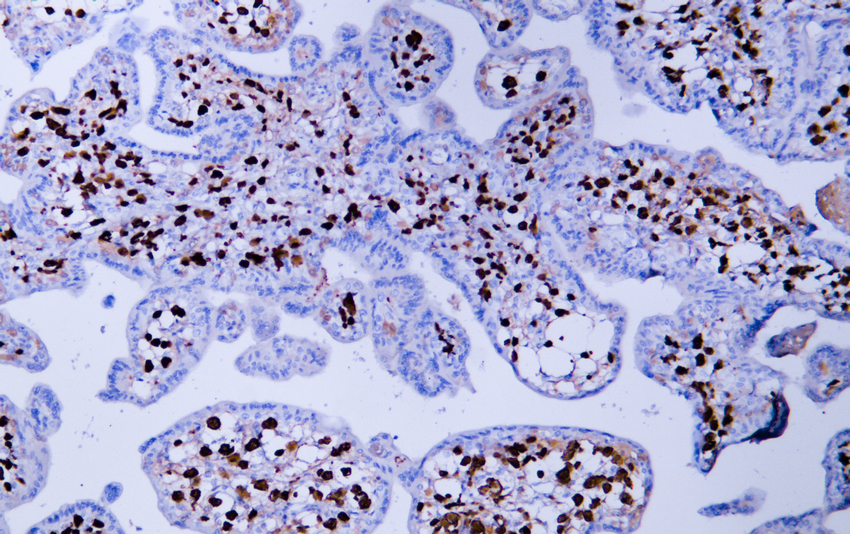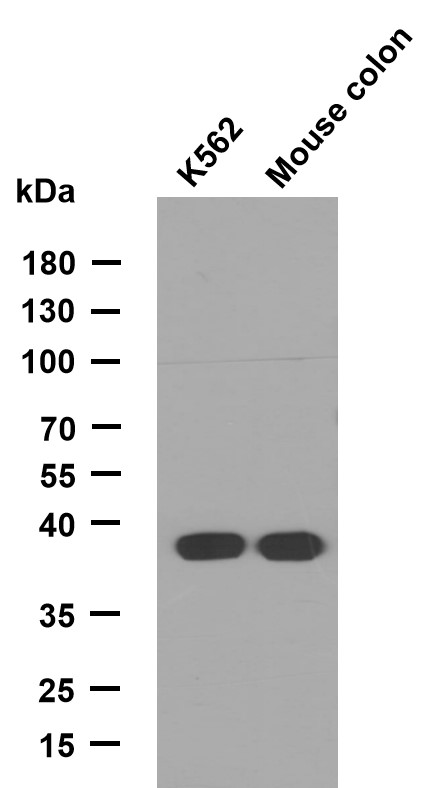Factor XIIIa (ABT170) mouse mAb
- Catalog No.:YM6873
- Applications:IHC;ELISA
- Reactivity:Human;Mouse;Rat;
- Target:
- Factor XIIIa
- Fields:
- >>Complement and coagulation cascades;>>Coronavirus disease - COVID-19
- Gene Name:
- F13A1 F13A
- Protein Name:
- Factor XIIIa
- Human Gene Id:
- 2162
- Human Swiss Prot No:
- P00488
- Immunogen:
- Synthesized peptide derived from human Factor XIIIa AA range: 400-500
- Specificity:
- The antibody can specifically recognize human Factor XIIIa protein.
- Formulation:
- PBS, 50% glycerol, 0.05% Proclin 300, 0.05%BSA
- Source:
- Mouse, Monoclonal/IgG1, kappa
- Dilution:
- IHC 1:200-400. ELISA 1:500-5000
- Purification:
- The antibody was affinity-purified from ascites by affinity-chromatography using specific immunogen.
- Storage Stability:
- -15°C to -25°C/1 year(Do not lower than -25°C)
- Other Name:
- Coagulation factor XIII A chain (Coagulation factor XIIIa;EC 2.3.2.13;Protein-glutamine gamma-glutamyltransferase A chain;Transglutaminase A chain)
- Molecular Weight(Da):
- 76kD,83kD
- Observed Band(KD):
- 83kD
- Background:
- This gene encodes the coagulation factor XIII A subunit. Coagulation factor XIII is the last zymogen to become activated in the blood coagulation cascade. Plasma factor XIII is a heterotetramer composed of 2 A subunits and 2 B subunits. The A subunits have catalytic function, and the B subunits do not have enzymatic activity and may serve as plasma carrier molecules. Platelet factor XIII is comprised only of 2 A subunits, which are identical to those of plasma origin. Upon cleavage of the activation peptide by thrombin and in the presence of calcium ion, the plasma factor XIII dissociates its B subunits and yields the same active enzyme, factor XIIIa, as platelet factor XIII. This enzyme acts as a transglutaminase to catalyze the formation of gamma-glutamyl-epsilon-lysine crosslinking between fibrin molecules, thus stabilizing the fibrin clot. It also crosslinks alpha-2-plasmin inhibitor, or
- Function:
- catalytic activity:Protein glutamine + alkylamine = protein N(5)-alkylglutamine + NH(3).,cofactor:Binds 1 calcium ion per subunit.,disease:Defects in F13A1 are the cause of F13A deficiency [MIM:134570]. F13A deficiency is an autosomal recessive disorder characterized by a life-long bleeding tendency, impaired wound healing and spontaneous abortion in affected women. In addition to the common presentation such as subcutaneous and intramuscular haematomas, severe bleeding such as intracranial hemorrhages may occur.,function:Factor XIII is activated by thrombin and calcium ion to a transglutaminase that catalyzes the formation of gamma-glutamyl-epsilon-lysine cross-links between fibrin chains, thus stabilizing the fibrin clot. Also cross-link alpha-2-plasmin inhibitor, or fibronectin, to the alpha chains of fibrin.,online information:Factor XIII entry,online information:The Singapore human
- Subcellular Location:
- Cytoplasmic
- Expression:
- Cytoplasmic
- June 19-2018
- WESTERN IMMUNOBLOTTING PROTOCOL
- June 19-2018
- IMMUNOHISTOCHEMISTRY-PARAFFIN PROTOCOL
- June 19-2018
- IMMUNOFLUORESCENCE PROTOCOL
- September 08-2020
- FLOW-CYTOMEYRT-PROTOCOL
- May 20-2022
- Cell-Based ELISA│解您多样本WB检测之困扰
- July 13-2018
- CELL-BASED-ELISA-PROTOCOL-FOR-ACETYL-PROTEIN
- July 13-2018
- CELL-BASED-ELISA-PROTOCOL-FOR-PHOSPHO-PROTEIN
- July 13-2018
- Antibody-FAQs
- Products Images

- Human dermatofibrosarcoma protuberans tissue was stained with Anti-Factor XIIIa (ABT170) Antibody

- Human placenta tissue was stained with Anti-Factor XIIIa (ABT170) Antibody

- Human schwannoma tissue was stained with Anti-Factor XIIIa (ABT170) Antibody

- Human tonsil tissue was stained with Anti-Factor XIIIa (ABT170) Antibody



